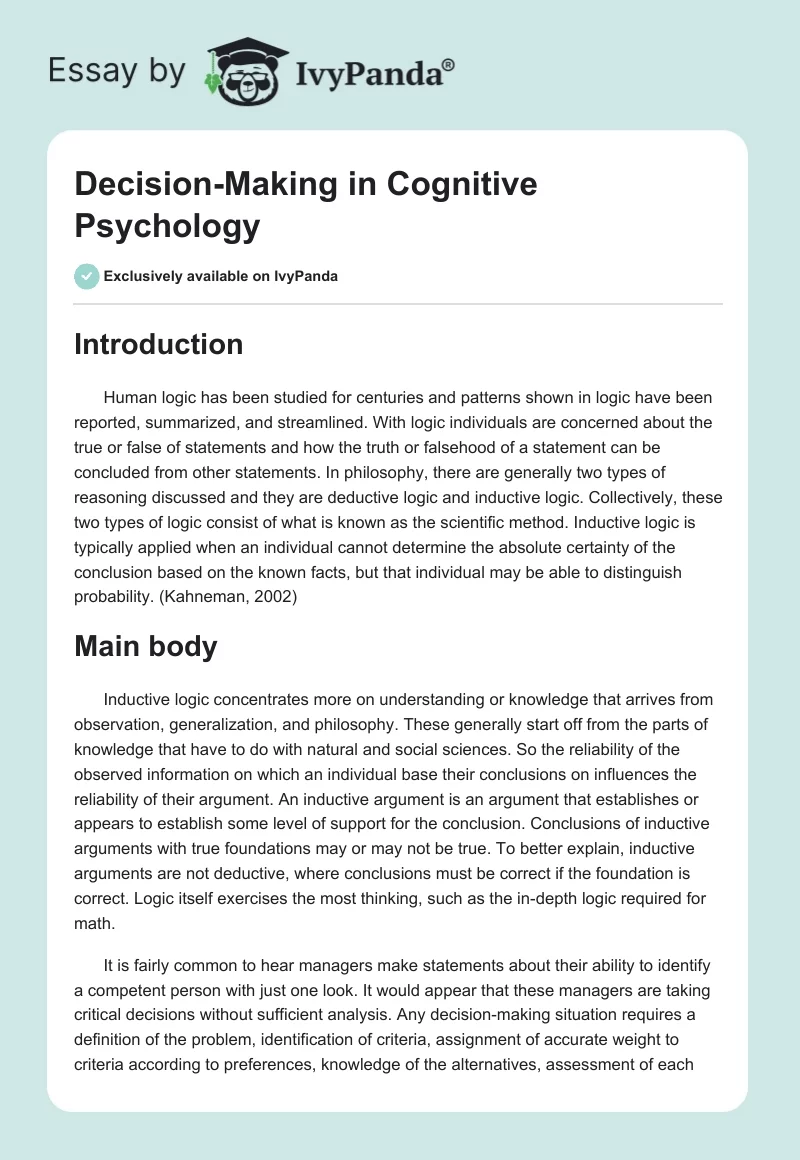Introduction
Human logic has been studied for centuries and patterns shown in logic have been reported, summarized, and streamlined. With logic individuals are concerned about the true or false of statements and how the truth or falsehood of a statement can be concluded from other statements. In philosophy, there are generally two types of reasoning discussed and they are deductive logic and inductive logic. Collectively, these two types of logic consist of what is known as the scientific method. Inductive logic is typically applied when an individual cannot determine the absolute certainty of the conclusion based on the known facts, but that individual may be able to distinguish probability. (Kahneman, 2002)
Main body
Inductive logic concentrates more on understanding or knowledge that arrives from observation, generalization, and philosophy. These generally start off from the parts of knowledge that have to do with natural and social sciences. So the reliability of the observed information on which an individual base their conclusions on influences the reliability of their argument. An inductive argument is an argument that establishes or appears to establish some level of support for the conclusion. Conclusions of inductive arguments with true foundations may or may not be true. To better explain, inductive arguments are not deductive, where conclusions must be correct if the foundation is correct. Logic itself exercises the most thinking, such as the in-depth logic required for math.
It is fairly common to hear managers make statements about their ability to identify a competent person with just one look. It would appear that these managers are taking critical decisions without sufficient analysis. Any decision-making situation requires a definition of the problem, identification of criteria, assignment of accurate weight to criteria according to preferences, knowledge of the alternatives, assessment of each alternative based on the criteria, and finally, choosing the alternative with the highest value. (Zey, M.1992)
This process of decision-making is called rational and is expected to lead to optimal results. Yet, in the everyday life of a manager, it appears that decisions are taken without such a complex process. The practice of management seems to present a seemingly non-rational process of decision-making. By studying such real-life practices of decision-makers, researchers identified the real-world phenomena of bounded rationality of managers in making decisions.
Bounded rationality is using limited information and limited analyses so as to get the first acceptable decision rather than the best possible solution. While optimality of solutions has been the main concern of decision-making theorists, it appears that real-life decision-makers satisfy under bounded rationality conditions. When we see people making decisions in a flash, it is likely that they are satisfied. The real world is probably fuller of satisfiers than optimizers in so far as decision-making is concerned.
Over a period of time, managers develop rules of thumb to minimize the need to process information for making decisions. The judgments that managers adopt are based on the growth of such rules of thumb that are called heuristics. These heuristics provide an easy way for managers to overcome the pressure of time in decision-making in a complex world. While usage of heuristics is a common managerial behavior, it cannot be said that it is always used with accuracy and complete awareness. It has been found that managers use such thumb rules without even being aware of the appropriateness of the specific heuristic to the situation on hand. It is possible that the heuristics have biases, which have affected the manager’s experience.
Conclusion
Most of us in our work life would have experienced consequences of bias, both as decision-makers and as those affected by the decisions of others. Such bias is particularly damaging in the case of people-related decisions. In many cases, such bias in decision-making is a direct result of using heuristics. (Selly, 2002) Researchers in decision making have identified three categories of heuristics that seem to affect the way people make decisions: representativeness heuristic, Availability heuristic, and anchoring and adjustment.
References
Kahneman, D. P. Slovic, and A. Tversky, eds, 2002: Judgment under Uncertainty: Heuristics and Biases. Cambridge: Cambridge University Press.
Selly, M.S. and Forman, E.H. (2002), Decision by Objectives, World Scientific Pub Co.
Zey, M. (1992), Decision Making: Alternatives to Rational Choice Models, Sage Publications, Newbury Park, California.


